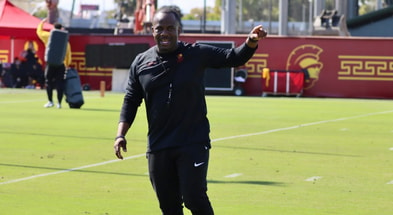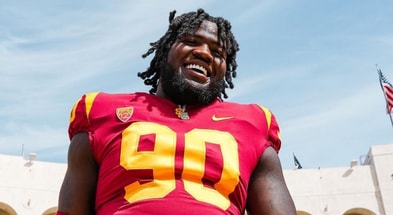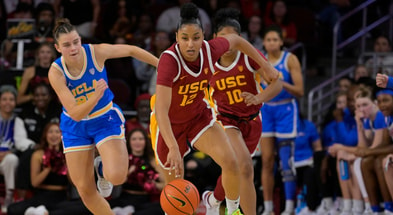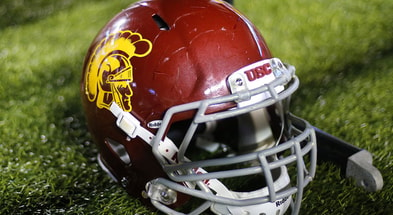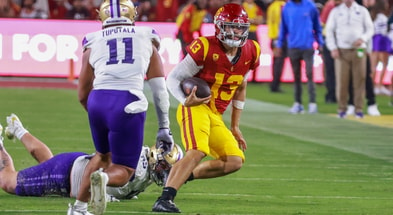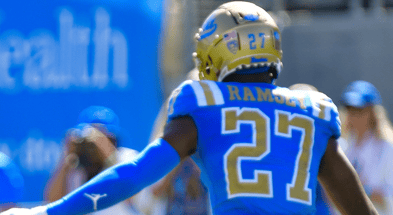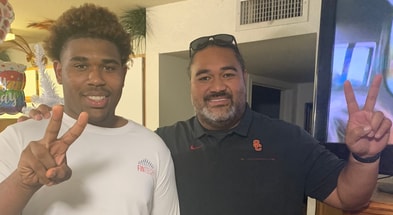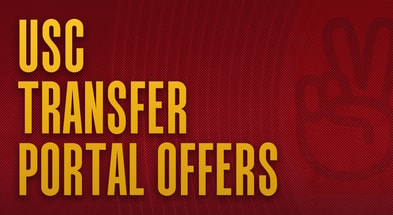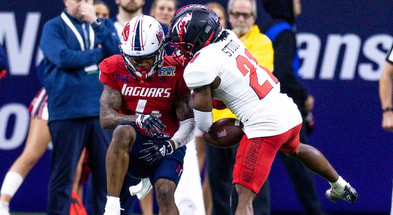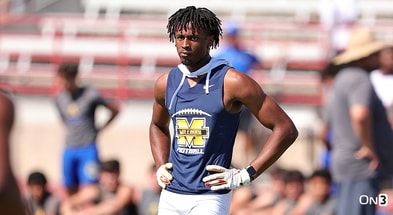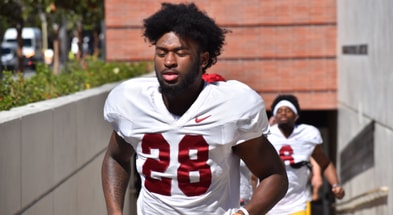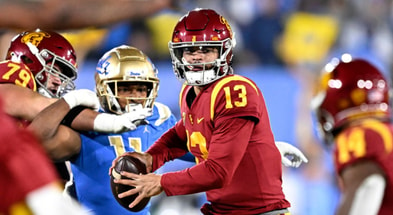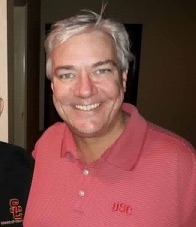Musings from Arledge: Getting better or getting worse, and the 2020 season
It’s coaching gospel that you’re either getting better or you’re getting worse. I don’t know if this is really true, but practically every coach says it, including a bunch of the legends, and that makes the saying practically a fact in the football world.
So if you’re a head coach trying to protect your career and $4.5 million dollar salary – to pick a number completely at random – you have every incentive to convince the world that your program is on the upswing. You’re either getting better or you’re getting worse, son, and there’s no question that we’re getting better.
So after the Oregon loss, you get the usual coachspeak from Clay Helton:
“We put ourselves in position [to win a championship], and our kids are really so close. We have made such strides. This has been a young group that I’ve watched grow up and I just think about two years ago, and the struggles we went through. Last year, really coming along with Kedon (Slovis) and really playing our best ball down the stretch of the season, and now this year winning the Pac-12 South and putting ourselves in a championship game…. We’re really close, but obviously we didn’t get it done tonight and that’s the next step.”
We’ve come so far, we’ve taken some big steps, now it’s just time to take that next step. Just wait until November next year. Okay. But is any of that actually true?
At first glance, 5-1 and a 7-point loss in the championship game seems like a step forward for the USC program. But the sample sizes in college football are so small – especially this year – and we all know that the difference between a win and a loss can be razor thin, and not easily explained by the usual coachspeak lingo. Yes, USC played with heart this year. But whose heart, exactly, caused ASU to drop a game-winning interception? Kedon’s? Amon-Ra’s? Clay Helton’s?
When a couple of freak plays – none of them clearly caused by anybody’s heart – make the difference between 5-1 and 3-3, it’s pretty foolish to focus only on the bottom-line number when trying to determine whether a team is, in fact, getting better or getting worse. I think this is why you don’t hear Nick Saban say things like, “We were 1-0 this week.” Instead, Nick Saban blows out an opponent and is deeply unhappy with the entire world, saying things like, “I don’t think that we really beat the other team when you give up 31 points like we did today….”
You’re either getting better or you’re getting worse, and giving up 31 points to Arkansas certainly isn’t an indication that you’re getting better, at least according to Saint Nick.
So let’s dive in.
I note, first, that the eyeball test doesn’t seem to support Clay’s “We’re Almost To The Mountaintop” proclamation. Despite the five wins to start the season, USC didn’t look very good other than a couple of quarters here and there. And the fact that it took three last-minute comebacks against teams that finished with losing records might make some of us question Clay’s assertion that it’s getting better all the time. It certainly made the playoff committee hesitant.
But we all have our prejudices, and those might affect how we see the eyeball test. So what do the numbers say?
USC gained 416.7 yards per game this year, a pretty mediocre number, and gave up 369.7 yards per game. Both stats put USC in the mid-40’s nationally. But dig in a little deeper, and the numbers look worse. USC averaged 5.4 yards per play – a terrible number, good for 74th in the country, and the Trojans gave up 5.3 yards per play (51st in the nation). The lack of any difference between offensive and defensive efficiency is usually the sign of a team that is average at best. The first down numbers tell the same story; the Trojans averaged 22.5 first downs per game and gave up 21.0 first downs per game. These are not Knock, Knock, Knocking on Championship Door numbers. Indeed, USC was a better team offensively last year. In 2019, USC averaged 6.5 yards per play, and while it was slight better defensively this year, as the Trojans gave up 5.7 yards per play in 2019, the yards-per-play differential was better last year, before USC allegedly took these major steps forward.
Where USC was better is in the turnover department, where the defense had a lot of success in the first five games. If not for that success, the win-loss record would have looked dramatically different. Orlando and staff deserve credit for causing turnovers with their more-aggressive brand of defense. But turnovers are unpredictable, and when your chance of success hinges on being plus-two in the turnover department, watch out.
All in all, the numbers don’t show any sort of dramatic improvement. Other than turnovers caused, they seem to show a step back. So what explains the better record in 2020? That’s easy: the schedule. The schedule explains all of it. The reality is that 2019 was a more difficult schedule – a more typical USC schedule – and USC performed like a typical Clay Helton team against that schedule.
In fact, with five full years of data, Clay Helton’s teams are very predictable at this point.
Clay Helton almost never loses against teams who finish the season with losing records. He was 4-0 against teams with losing records this year, and he is 25-1 overall in his five full seasons as USC head coach. (I cut out the interim games from 2015 as part of this analysis, because Clay Helton did not have full control over that football team until midseason and did not have an offseason to establish his systems.) His teams often play sloppy, uninspired football against bad teams, but they seldom lose those games.
Against teams that finish the season with winning records, Helton is not good. USC was 1-1 this year and is 14-18 in Helton’s five full seasons. His track record shows that he is going to lose slightly more than 50% of his games against teams with winning records. With only two games against teams with winning records in 2020, his 1-1 mark is about what you’d expect.
Against “elite” teams – and I use this term to refer to any team that finishes the season with at least 10 wins, a pretty generous definition of “elite” since it includes not only 2016 Alabama but also 2018 Wazzu and 2016 Colorado – Clay Helton is 5-9 overall and only 2-7 if you exclude Clay’s first full season where Sam Darnold led the team to the Rose Bowl victory.
So why was USC 5-1 this year? Because the team improved? No, because Clay Helton – with a good bit of luck, as you know – managed to beat the teams with losing records, split against the two teams with winning records, and didn’t have to play a single elite team. Had USC played its full 2020 schedule, things would have looked different. Of the five best teams in the conference (not including USC itself), the Trojans played only two of them – Oregon and Utah. They should have played three more: Colorado, Washington, and Stanford. They likely would have lost one or two of those. And they would have played two elite teams, both of which were likely losses (make that one likely loss and one Little Big Horn). And that means against the full 2020 slate, USC likely would have been 8-4 or 7-5. 2020 would have been consistent with 2019.
It seems to me that USC is simply treading water. If you compare Clay Helton to the other post-Carroll coaches (Kiffin, Sark, and, briefly, Orgeron), you see something remarkable: the other post-Carroll coaches were a combined 46-23. Clay Helton is 45-23. Getting better? Getting worse? How about doing nothing at all, ever.
But if we had to choose either getting better or getting worse – and Bo Schembechler says it’s one or the other! – I think I’d choose getting worse, and for two simple reasons. The other post-Carroll coaches put their identical record together while dealing with the harshest sanctions since SMU’s. You would think that the end of the sanctions would make life easier for a coach. No, scratch that. Of course, the end of sanctions make things easier for a coach.
Second, I think Sarkisian and Kiffin recruited better than Helton has. The team Clay inherited in 2016 had six players that would be drafted in the first two rounds of the NFL draft — Sam Darnold, JuJu Smith-Schuster, Ronald Jones, Adoree Jackson, Michael Pittman, and Uchenna Nwosu – and another, Zach Banner, who was drafted in the third round and would be an NFL starter. If Clay Helton left today – this is just a hypothetical, not a prayer; fine, it’s both – I don’t think his successor would inherit that level of elite talent on the roster. When Amon-Ra, Hufanga, and others almost certainly leave after this season, he will leave a roster that has less talent than the one he inherited.
Same number of wins as the guys who coached through sanctions? Roster weaker than the coaches who recruited during sanctions? A shortened season that shows the team was no better than last year but simply played an easier schedule – and was remarkably fortunate not to be 3-3 against that watered-down schedule? No, sorry; USC did not take a major step towards being a championship-caliber team, and it is most certainly not “really close” to being a championship-level team. It is what it has been, and maybe even a tiny bit worse.
So for anybody who listens to Clay Helton and believes the team is on the verge of greatness – just one more step, fellas! – put those thoughts away. We can already predict what USC will do next year.
The Trojans play nine conference games. Four of those teams are likely to finish with a losing record. USC will beat all of them. Four of them will have winning records but finish with less than ten wins. USC splits those games. And one of them – probably Oregon – is likely to be an elite team that finishes with at least ten wins. USC likely loses that game. That’s 6-3 in conference.
In non-conference games, USC will beat San Jose State – though that program is much improved, and Clay’s teams never play well in the opener, so this is no gimme – and USC will almost certainly lose to Notre Dame in South Bend. That leaves BYU as the toss-up game that determines whether USC finishes 8-4 or 7-5 in the regular season.
And if one of those lucky bounces that went Clay’s way goes the other way next year, USC is looking at 6-6 or 7-5. The numbers are predictable at this point. We don’t need Nostradamus to help us figure this out.
So USC will be the only ranked team to forego a bowl game, huh? And people question whether USC is committed to football. Given the choice between playing Texas in a primetime game – the first and only game of the season where fans would be able to attend in-person – and sitting at home, USC chooses the couch.
Is that because COVID is so dangerous that the bowl game would be a massive risk? Of course not. They managed to play six games, and we haven’t heard a single anecdote about any person being hurt as a result. And believe me, if that information existed, we’d be hearing all about it.
If USC were headed to a playoff semifinal or even the Fiesta Bowl, would be Trojans be choosing the Lazy Boy and a Snuggie? Of course not. They would play, and not a single person associated with the program would believe they were endangering human life in the process.
USC is simply admitting that second-tier bowl games are a failure.
This makes a lot of sense now. While second-tier bowl games are Clay Helton’s home away from home, he never has seemed to care much for them. He didn’t bother to practice before the Holiday Bowl against Wisconsin, and nobody even bothered to show up for last year’s Holiday Bowl against Iowa. It’s big time or bust for the Trojans, I suppose.
And, strangely enough, Clay Helton and I seem to be on the same page for once. Here’s more from the head man after Oregon:
“We’re judged on championships here, that’s the beauty of this place, that’s the expectation, that’s the standard. That’s what we play for and that’s why hearts are broken in that locker room. That’s the only thing we’ll accept as a team, a championship.”
Well, what do we make of that, coach? You have one conference championship in five years. Tollner had one of those in four years. Smith had three in his six years. One conference title in five years is not success at USC. And this program the last five years has never been within ten light years of a national title. So if you’re telling us the truth, if you’re judged on championships, if that’s the expectation, the standard, then this season is a failure.
Carthago delenda est.
